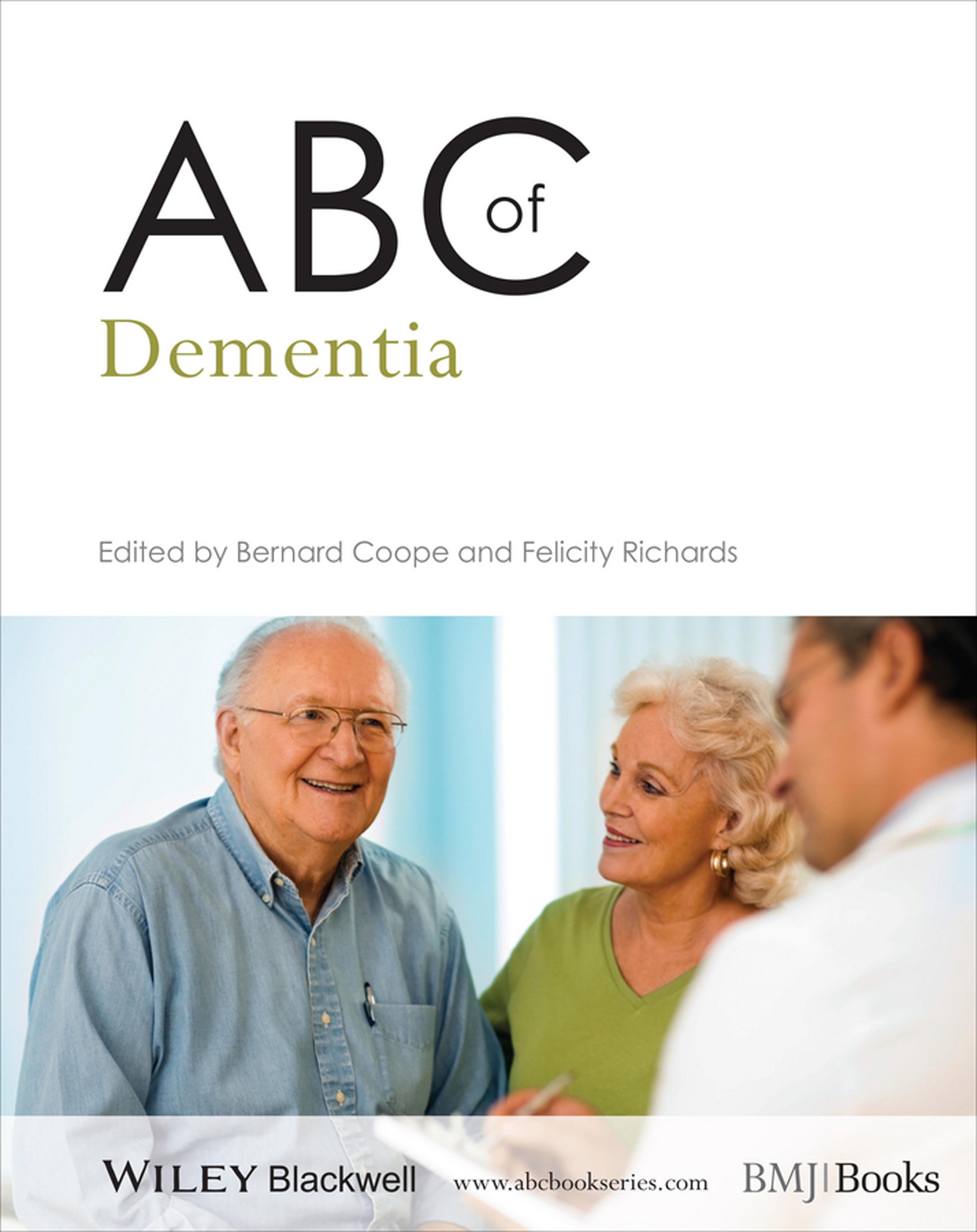ABC of dementia Second Edition Coope Visit to download the full and correct content document: https://ebookmass.com/product/abc-of-dementia-second-edition-coope/
More products digital (pdf, epub, mobi) instant download maybe you interests ...
Diagnosis and Management in Dementia: The Neuroscience of Dementia, Volume 1 1st Edition Colin R. Martin
https://ebookmass.com/product/diagnosis-and-management-indementia-the-neuroscience-of-dementia-volume-1-1st-edition-colinr-martin/
ABC of Wound Healing 2nd Edition Annie Price
https://ebookmass.com/product/abc-of-wound-healing-2nd-editionannie-price/
ABC of Clinical Reasoning (ABC Series), 2e (Dec 19, 2022)_(1119871514)_(Wiley-Blackwell) 2nd Edition Nicola Cooper
https://ebookmass.com/product/abc-of-clinical-reasoning-abcseries-2e-dec-19-2022_1119871514_wiley-blackwell-2nd-editionnicola-cooper/ Encyclopedia of Bioinformatics and Computational Biology: ABC of Bioinformatics Shoba Ranganathan
https://ebookmass.com/product/encyclopedia-of-bioinformatics-andcomputational-biology-abc-of-bioinformatics-shoba-ranganathan/
Dementia, Narrative and Performance: Staging Reality, Reimagining Identities 1st Edition Janet Gibson
https://ebookmass.com/product/dementia-narrative-and-performancestaging-reality-reimagining-identities-1st-edition-janet-gibson/
My First Book of Arabic Words: An ABC Rhyming Book of Arabic Language and Culture Khalil
https://ebookmass.com/product/my-first-book-of-arabic-words-anabc-rhyming-book-of-arabic-language-and-culture-khalil/
Sunshine and Sammy (Vested Interest: ABC Corp Book 5) Melanie Moreland
https://ebookmass.com/product/sunshine-and-sammy-vested-interestabc-corp-book-5-melanie-moreland/
Handbook of Forensic Pathology, Second Edition 2nd
https://ebookmass.com/product/handbook-of-forensic-pathologysecond-edition-2nd/
Sustainability of Construction Materials, Second Edition Khatib
https://ebookmass.com/product/sustainability-of-constructionmaterials-second-edition-khatib/
Dementia Dementia EDITEDBY
BernardCoope,MBChB,MMedSci,MRCPsych
AssociateMedicalDirector,ConsultantOlderAdultPsychiatrist
WorcestershireHealthandCareNHSTrust
FelicityA.Richards,MBChB,MRCPsych,DGM
ConsultantOlderAdultPsychiatrist
WorcestershireHealthandCareNHSTrust
Thiseditionfirstpublished2014©2014byJohnWiley&SonsLtd.
BMJBooksisanimprintofBMJPublishingGroupLimited,usedunderlicencebyJohnWiley&Sons.
Registeredoffice: JohnWiley&Sons,Ltd,TheAtrium,SouthernGate,Chichester,WestSussex,PO198SQ,UK
Editorialoffices: 9600GarsingtonRoad,Oxford,OX42DQ,UK
TheAtrium,SouthernGate,Chichester,WestSussex,PO198SQ,UK
111RiverStreet,Hoboken,NJ07030-5774,USA
Fordetailsofourglobaleditorialoffices,forcustomerservicesandforinformationabouthowtoapplyforpermissiontoreusethe copyrightmaterialinthisbookpleaseseeourwebsiteatwww.wiley.com/wiley-blackwell
TherightoftheauthortobeidentifiedastheauthorofthisworkhasbeenassertedinaccordancewiththeUKCopyright,Designsand PatentsAct1988.
Allrightsreserved.Nopartofthispublicationmaybereproduced,storedinaretrievalsystem,ortransmitted,inanyformorbyany means,electronic,mechanical,photocopying,recordingorotherwise,exceptaspermittedbytheUKCopyright,DesignsandPatentsAct 1988,withoutthepriorpermissionofthepublisher.
Designationsusedbycompaniestodistinguishtheirproductsareoftenclaimedastrademarks.Allbrandnamesandproductnamesused inthisbookaretradenames,servicemarks,trademarksorregisteredtrademarksoftheirrespectiveowners.Thepublisherisnotassociated withanyproductorvendormentionedinthisbook.Itissoldontheunderstandingthatthepublisherisnotengagedinrendering professionalservices.Ifprofessionaladviceorotherexpertassistanceisrequired,theservicesofacompetentprofessionalshouldbesought.
Thecontentsofthisworkareintendedtofurthergeneralscientificresearch,understanding,anddiscussiononlyandarenotintendedand shouldnotberelieduponasrecommendingorpromotingaspecificmethod,diagnosis,ortreatmentbyhealthsciencepractitionersforany particularpatient.Thepublisherandtheauthormakenorepresentationsorwarrantieswithrespecttotheaccuracyorcompletenessofthe contentsofthisworkandspecificallydisclaimallwarranties,includingwithoutlimitationanyimpliedwarrantiesoffitnessforaparticular purpose.Inviewofongoingresearch,equipmentmodifications,changesingovernmentalregulations,andtheconstantflowofinformation relatingtotheuseofmedicines,equipment,anddevices,thereaderisurgedtoreviewandevaluatetheinformationprovidedinthe packageinsertorinstructionsforeachmedicine,equipment,ordevicefor,amongotherthings,anychangesintheinstructionsor indicationofusageandforaddedwarningsandprecautions.Readersshouldconsultwithaspecialistwhereappropriate.Thefactthatan organizationorWebsiteisreferredtointhisworkasacitationand/orapotentialsourceoffurtherinformationdoesnotmeanthatthe authororthepublisherendorsestheinformationtheorganizationorWebsitemayprovideorrecommendationsitmaymake.Further, readersshouldbeawarethatInternetWebsiteslistedinthisworkmayhavechangedordisappearedbetweenwhenthisworkwaswritten andwhenitisread.Nowarrantymaybecreatedorextendedbyanypromotionalstatementsforthiswork.Neitherthepublishernorthe authorshallbeliableforanydamagesarisingherefrom.
LibraryofCongressCataloging-in-PublicationData
ABCofdementia/editedbyBernieCoopeandFelicityA.Richards. p.;cm.
Includesbibliographicalreferencesandindex.
ISBN978-1-118-47402-0(pbk.)
I.Coope,Bernie,1964–editor.II.Richards,FelicityA.(FelicityAnn),1979–editor.[DNLM:1.Dementia–diagnosis–GreatBritain. 2.Dementia–therapy–GreatBritain.WM220]
RC521
616.8′ 3–dc23
2013046742
AcataloguerecordforthisbookisavailablefromtheBritishLibrary.
Wileyalsopublishesitsbooksinavarietyofelectronicformats.Somecontentthatappearsinprintmaynotbeavailableinelectronicbooks.
Coverimage:iStockphoto.com/stevecoleimages
CoverdesignbyMeadenCreative
Setin9.25/12MinionProbyLaserwordsPrivateLtd,Chennai,India
ListofContributors,vii
Introduction–ACalltoAction,ix
1 DementiaintheUK,1 BernardCoope
2 CausesofDementia,5 GeorgiosTheodoulou
3 Assessment,10 BernardCoopeandFelicityA.Richards
4 EarlyInterventionforDementia,14 BernardCoopeandTanyaJacobs
5 DrugTreatment,18 SolmazSadaghiani
6 DementiaandFamilies,22 JennyLaFontaine
7 Person-CentredCare,26 DawnBrooker
8 BehaviouralandPsychologicalSymptomsofDementia(BPSD),31 DhanjeevMarrieandSallyWilliams
9 DementiainYoungerPeople,37 PeterBentham
10 DementiainPrimaryCare,42 SimonRumley
11 DementiaintheAcuteHospital,47 ElizabethWard,DarylL.LeungandGeorgiosTheodoulou
12 DementiaandtheLaw,51 FelicityA.RichardsandJelenaJankovic
13 End-of-LifeCareinDementia,56 KaydeVries Index,61
ListofContributors PeterBentham
BirminghamMemoryAssessmentandRareDementiaServices, Birmingham,UK
DawnBrooker
AssociationforDementiaStudies,UniversityofWorcester,Worcester,UK
BernardCoope
WorcestershireHealthandCareNHSTrust,Worcestershire,UK
TanyaJacobs
WorcestershireHealthandCareNHSTrust,Worcestershire,UK
JelenaJankovic
DudleyandWalsallMentalHealthPartnershipTrust,Dudley,UK
JennyLaFontaine
AssociationforDementiaStudies,UniversityofWorcester,HenwickGrove, Worcester,UK
DarylL.Leung
ElderlyCareandDementiaServiceRoyalWolverhamptonNHSTrust, Wolverhampton,UK
DhanjeevMarrie
WorcestershireHealthandCareNHSTrust,Worcestershire,UK
FelicityA.Richards
WorcestershireHealthandCareNHSTrust,Worcestershire,UK
SimonRumley
AylmerLodgeCookleyPartnership,Kidderminster,Worcestershire,UK
SolmazSadaghiani
WorcestershireHealthandCareNHSTrust,Worcestershire,UK
GeorgiosTheodoulou
WorcestershireHealthandCareNHSTrust,Worcestershire,UK
KaydeVries
GraduateSchoolofNursing,Midwifery&Health(GSNMH), VictoriaUniversityofWellington,NZ;AssociationforDementiaStudies, UniversityofWorcester,UK;UniversityofWashington,Seattle,USA
ElizabethWard
RoyalWolverhamptonNHSTrust,Wolverhampton,UK
SallyWilliams
WorcestershireHealthandCareNHSTrust,Worcestershire,UK
Introduction–ACalltoAction BernardCoopeandFelicityA.Richards WorcestershireHealthandCareNHSTrust,Worcestershire,UK
Historically,dementiahasnotfeaturedhighlyinthetrainingof eithermedicalstudentsorjuniordoctors.Dementiaisnowgaining increasingrecognitionasahealthcareissueinit’sownright.The fieldofdementiacareistransformingrapidly(Figure1),and whatevertheareaofhealthcareyouareinvolvedin,youwillat somepointbetouchedbydementia.Withthiscomestheneedfor allclinicianstolearnaboutdementia.Itishopedthatthisbookwill playitspartinhelpingcliniciansunderstandtheevolvingnatureof theevidencebase,changesinsocietalexpectationsandtheeffects dementiahasontheperson,theirfamilyandthehealthservice.
Whyistheneedtolearnaboutdementia changing?
Theevidencebase
Thepasttwodecadeshaveseenarapidgrowthinthescientific understandingofdementiaandthebraindiseasesthatcauseit, includingdevelopmentsinneuropathology,aetiology,imagingand theroleofgenetics.Inturn,thisknowledgeledtotheintroduction ofpharmacologicaltreatmentsand,consequently,anevidencebase fortheirlimitedeffectiveness.Asyet,noavailabletreatmentsmodifythebraindiseasescausingdementiaandthereisnoevidenceto supportscreeningprogrammes.
Continuedresearchhasalsoledtothediscoverythatmanyofthe treatmentsthathavebeenusedfordecadeswiththeclinicalaimof helpingpeoplewithdementiadomoreharmthangood.Sedating treatmentssuchasantipsychoticsareoflittleclinicaleffectiveness andareknowntoincreasemortalityinthosepatientsprescribed them.Fortunately,wearemovingawayfrompharmacological treatmentstowardsarangeofnon-medicalinterventionstohelp thosemostdistressedormostchallengingtocarefor.Centralto thishasbeentheflourishingofresearchandtheoryinthefieldof person-centredcare.
Afinalillustrationofthechangingevidencebaseisthedemonstrationoftheeffectivenessofserviceinterventions.Supporting carersbyprovidinginformationandemotionalsupportcan prolongacarer’sabilitytoprovidecareathome,reducingthe
ABCofDementia,FirstEdition.EditedbyBernardCoopeandFelicityRichards. ©2014JohnWiley&Sons,Ltd.Published2014byJohnWiley&Sons,Ltd.
needforamovetolongertermplacement.Awell-madeand well-communicatedearlydiagnosis,backedupbypost-diagnostic support,canimprovethequalityofcareforthepersonwithdementiaandtheirfamilies,aswellasreducingtheriskofcrisesinthe future.
Changesinsociety Dementiaisaconditionthatgetscommonerwithage.Morethan halfofthosewithdementiaintheUKareover80.Itisthisagegroup thatisgrowingincountriesacrosstheworldandwiththisgrowth, thenumberofpeoplewithdementiaisclimbing.
Asthenumberofpeoplewithdementiahasbeenrising,thestructureoffamilieshasbeenchanging.Closemembersofthefamily havetraditionallysteppedintoprovidecareforpeoplewithdementia,withthemajorityofcarersbeingeitherspousesordaughters. Thereisanincreasingtrendforpeopletoenteroldageseparated andforchildrentobelivingatagreaterdistancefromtheirparentsandtobeinfulltimework.Thecapacityoffamilymembersto takeonacaringrolewillhaveanimpactonwhatisexpectedfrom professionalsinhealthandsocialcare.
Evidence Base
Changing Role for Dementia Care Policy
Changes in Society
Figure1 Thechangingfieldofdementiacare.
Box1 DementiaActionAlliance:CalltoAction
1.Ihavepersonalchoiceandcontrolorinfluenceover decisionsaboutme
• Ihavecontrolovermylifeandsupporttodothethingsthat mattertome.
• Ihavereceivedanearlydiagnosis,whichwassensitively communicated.
• Ihaveaccesstoadequateresources(privateandpublic)that enablemetochoosewhereandhowIlive.
• IcanmakedecisionsnowaboutthecareIwantinmylaterlife.
• Iwilldiefreefrompain,fearandwithdignity,caredforbypeople whoaretrainedandsupportedinhigh-qualitypalliativecare.
2.Iknowthatservicesaredesignedaroundmeand myneeds
Ifeelsupportedandunderstoodbymygeneralpractitioner(GP)and getaphysicalcheck-upregularlywithoutaskingforit.
Therearearangeofservicesthatsupportmewithanyaspectofdaily livingandenablemetostayathomeandinmycommunity,enjoyingthebestqualityoflifeforaslongaspossible.
IamtreatedwithdignityandrespectwheneverIneedsupportfrom services.
IonlygointohospitalwhenIneedtoandwhenIgettherestaff understandhowIcanreceivethebesttreatmentsothatIcanleave assoonaspossible.
Carehomestaffunderstandalotaboutmeandmydisabilityand knowwhathelpsmecopeandenjoythebestqualityoflifeevery day.
Mycarercanaccessrespitecareifandwhenneeded,alongwithother servicesthatcanhelpsupportthemintheirrole.
3.Ihavesupportthathelpsmelivemylife
• Icanchoosewhatsupportsuitsmebest,sothatIdon’tfeela burden.
• Icanaccessawiderangeofoptionsandopportunitiesforsupport thatsuitsmeandmyneeds.
• IknowhowtogetthissupportandIamconfidentitwillhelpme.
• IhaveinformationandsupportandIcanhavefunwithanetwork ofothers,includingpeopleinapositionsimilartomine.
• Mycareralsohasasupportnetworkthatsuitstheirownneeds.
4.Ihavetheknowledgeandknow-howtogetwhatIneed
• It’snotaproblemgettinginformationandadvice,including informationabouttherangeofbenefitsIcanaccesstohelpme affordandcopewithlivingathome.
• IknowwhereIcangettheinformationIneedwhenIneedit,and Icandigestandre-digestitinawaythatsuitsme.
• Ihaveenoughinformationandadvicetomakedecisionsabout managing,nowandinthefuture,asmydementiaprogresses.
• Mycarerhasaccesstofurtherrelevantinformation,and understandswhichbenefitstheyarealsoentitledto.
5.IliveinanenablingandsupportiveenvironmentwhereI feelvaluedandunderstood
• Ihadadiagnosisveryearlyonand,ifIwork,anunderstanding employer,whichmeansIcanstillworkandstayconnectedto peopleinmylife.
• Iammakingacontribution,whichmakesmefeelvaluedand valuable.
• Myneighbours,friends,familyandGPkeepintouchandare pleasedtoseeme.
• Iamlistenedtoandhavemyviewsconsidered,fromthepointI wasfirstworriedaboutmymemory.
• Theimportanceofhelpingmetosustainrelationshipswithothers iswellrecognised.
• IfIdevelopbehaviourthatchallengesothers,peoplewilltaketime tounderstandwhyIamactinginthiswayandhelpmetotryto avoidit.
• Mycarer’sroleisrespectedandsupported.Theyalsofeelvalued andvaluable,andneitherofusfeelsalone.
6.Ihaveasenseofbelongingandofbeingavaluedpartof family,communityandciviclife
• Ifeelsafeandsupportedinmyhomeandinmycommunity,which includesshopsandpubs,sportingandculturalopportunities.
• NeithermyfamilynorIfeelashamedordiscriminatedagainst becauseIhavedementia.Peoplewithwhomwecomeinto contactarehelpfulandsupportive.
• MycarerandIcontinuetohavetheopportunitytodevelopnew interestsandnewsocialnetworks.
• Itiseasyformetocontinuetoliveinmyownhome,andmycarer andIwillbothhavethesupportneededformetodothis.
7.Iknowthereisresearchgoingonthatdeliversabetterlife formenowandhopeforthefuture
• Iregularlyreadandhearaboutnewdevelopmentsinresearch.
• Iamconfidentthatthereisanincreasinginvestmentindementia researchintheUK.
• Iunderstandthegrowingevidenceaboutpreventionandrisk reductionofdementia.
• Asapersonlivingwithdementia,IamaskedifIwanttotakepart insuitableclinicaltrialsorparticipateinresearchinotherways.
• IbelievethatresearchiskeytoimprovingthecareI’mreceiving now.
• IbelievethatmoreresearchwillmeanthatmychildrenandIcan lookforwardtoarangeoftreatmentswhenIneeditandthere willbemoretreatmentsavailablefortheirgeneration.
• Iknowthatwithadiagnosisofdementiacomessupporttolive wellthroughassistivetechnologiesaswellasmoretraditional treatmenttypes
Atleastasimportantasdemographicgrowthisthechanging expectationsofanewgenerationofpeoplewithdementia,illustratedbytherelativelymoderndemandforearlydiagnosis.The pastdecadehasseenadramaticshiftfromindividuals‘turning ablindeye’tochangesintheirmentalperformance,toconcern aboutwhetherthesechangescouldrepresenttheonsetofdementia. Crucially,thisconcernisoftenaccompaniedbyawishtoknowif thisisthecaseandaskingforassessment.Thisnewopennesshas revealedanotherfact;peopleover50nowfeargettingdementia morethantheyfearcancer.
Policyandpolitics Dementiabecameapoliticalissuein2007followingpublication ofthereportbytheNationalAuditOffice‘Improvingservicesand
supportforpeoplewithdementia’.Includedinthereportwasan economicanalysiswhichshowedthatdementiacoststheUKmore thanheartdisease,strokeandcancercombined.Mostofthiscost wasforcare,eitherthroughSocialServicesordirectlybypatients andtheirfamilies,ratherthanNHScosts.Nolongerwasdementia aminormatter;itbecamethemostexpensivehealthconditionthe countryfaces.
OneconsequencewastheNationalDementiaStrategy,whichhas guidedchangesinNHScaresince,furtherclarifiedbytheintroductionoftheNationalInstituteforHealthandClinicalExcellence (NICE)DementiaStandards.Currently,dementiahasahighpoliticalprofile,withtheprimeministerlaunchinghisownDementia Challengein2012.
Thisbookiswrittenasapracticalguidetotheclinicianwho wishestohelpthelivesofthosetouchedbydementia.Perhaps thenweshallbeguidedbythevoiceofpatientsandthefamilies whosupportthem.TheDementiaActionAllianceismadeup ofover100organisations.Throughworkingwithpeoplewith dementiaandtheirfamilies,theDementiaActionAlliancedrewup theDementiaDeclaration:ACalltoAction,sevenambitiousbut achievablestatementsabouthowpeoplecanlivewellandwhatthey wouldwishforfromprofessionals–statementsweshouldconsider inoureverydayclinicalpractice(Box1).
OVERVIEW
DementiaintheUK BernardCoope WorcestershireHealthandCareNHSTrust,Worcestershire,UK
• Therearecurrently800000peoplewithdementiaintheUK, andthisnumberwillrisetooveramillionby2021.
• Dementiaisthemostexpensivehealthcareissuethecountry faces.Theeconomicimpactfor2012wasover£23billion,more thanheartdisease,strokeandcancercombined.
• Thesyndromeofdementiaconsistsofimpairmentofcognitive skills,resultingfromdiseaseofthebrain,whichissevereenough toimpairdailyfunctioning.
• Thereismoretodementiathanmemoryimpairment.
• Notalloldpeoplehavedementiaandnotallpeoplewith dementiaareold.
Introduction
Dementiaisaclinicalsyndrome.ThischapterexaminesthedefinitionofdementiaandexploresanumberofissuesrelatedtodementiaasitisexperiencedintheUK.
Definition:Thesyndromeofdementia
Thesyndromeofdementiaconsistsofthreecomponents:
1 impairmentofcognitiveskills, 2 resultingfromdiseaseofthebrain, 3 whicharesevereenoughtoimpairdailyfunctioning.
Itisworthtakingtimetolookattheimplicationsofthisdefinition.
• Dementiaasasyndrome.Centraltothedefinitionisachange inmentalskills.Todiagnosedementia,thesechangesneedtobe confidentlyidentified,whichusuallymeansobtainingacareful historysupportedbyanassessmentofmentalskills.Dementia relatestohowwellaperson’sbrainisworkingratherthanthepresenceofpathology,andcan’tbediagnosedfromabrainscanany morethanaplainX-rayofanarthriticjointcanshowpain.The diseasesthatcausedementiaarecoveredinChapter2.
ABCofDementia,FirstEdition.EditedbyBernardCoopeandFelicityRichards. ©2014JohnWiley&Sons,Ltd.Published2014byJohnWiley&Sons,Ltd.
• Cognitivefunctionsareadiverseassortmentofbrainactivity.Theterm‘cognitivefunctions’coversmemoryencoding, long-termstoresofknowledge,wordfinding,languagecomprehension,faceorobjectrecognition,planningandorganisingof activityandjudgement.Differentbraindiseasesleadtodifferent patternsofcognitivechange.Thereismoretodementiathan memoryimpairment.
• Todiagnosedementia,theremustbegoodreasontosuspect diseaseofthebrain.Brainimagingmayhelp,butinpractice, braindiseaseisusuallyinferredfromchangeinmentalskill.
• Itisquitepossibletohavebrainpathologywithoutdementia Asimagingtechniquesdevelop,itmaysoonbecommontodiagnoseAlzheimer’sdiseaseyearsbeforeanysymptomshavedeveloped.Vascularchangesonimagingareverycommonandontheir owndon’tmeanvasculardementia.
• Impairmentofdailyfunctioningisanimportantbutimprecise term.Veryminorchangesinmentalskillsarenotusuallyreferred toasdementia,althoughtheremaybeadifferenceofopinion betweenpatient,carerandclinicianaboutwhenthechangeof functioninghasoccurred.Forthosewithsomedetectablechanges inmentalfunctionthatarenotimpactingondailyfunctioning, theterm mildcognitiveimpairment (MCI)issometimesused.
• Whendiscussingdementia,weshouldbecarefulnottousesyndromeandpathologyasinterchangeableconcepts.
Terminology Inthe1970s,thelateGeriatricianBernardIsaacsencouragedthe useoftheterm‘chronicbrainfailure’asanalternativetodementia. Theaimwastoemphasiseorganfailureandtobringthedefinitioninlinewithothercommonlyusedterms,suchasheartfailure. ‘Acutebrainfailure’representeddelirium.Ultimately,thetermwas droppedasithadtoomanynegativeconnotations,buttheprincipleisworthreflectingon.Dementiaiswhatweexperiencewhen changesinbrainfunctionimpactondaytodaylife.
TheNationalAuditOfficeinitsgroundbreakingreport‘ImprovingServicesandSupportforPeoplewithDementia’tookamore bluntapproachandchosethesimpleterm‘progressiveandterminal braindisease’.Whilstthismaynotrespectthesyndrome/pathology distinction,ithadthemeritofcommunicatingtheseriousnessof dementiatoawiderangeofopinionformersandpoliticians.
Prevalenceanddemography TheAlzheimer’sSocietycollatedthefollowingfactsaboutdementia in2012.
• Therearecurrently800000peoplewithdementiaintheUK.
• Thereareover17000youngerpeoplewithdementiaintheUK.
• Thereareover11500peoplewithdementiafromblackand minorityethnicgroupsintheUK.
• Therewillbeoveramillionpeoplewithdementiaby2021.
• Two-thirdsofpeoplewithdementiaarewomen.
• Thereare670000carersofpeoplewithdementiaintheUK.
• FamilycarersofpeoplewithdementiasavetheUKover£8billion ayear.
• Eightypercentofpeoplelivingincarehomeshaveaformof dementiaorseverememoryproblems.
• Two-thirdsofpeoplewithdementialiveinthecommunitywhile one-thirdliveinacarehome.
• Only44%ofpeoplewithdementiainEngland,Walesand NorthernIrelandreceiveadiagnosis.
Economicimpact UntiltheNationalAuditOfficepublisheditsreportondementia in2007,dementiahadneverbeenconsideredapriority.Itwas theimpactofdementiaontheUKhighlightedinthisreportthat broughtaboutanewpoliticalwilltoaddressthecondition.The reportdetailedtherealsituationaboutdementia–notonlyhow muchtheNHSandSocialServiceswerespendingondementia butalsowhatindividualsspentontheirowncareandhowmuch lostearningscouldbeattributedtocarerstakingtimeoffworkto providecare.Theanswerwasalittleover£17billion.
Thesignificanceofthissumwasthatifotherconditionsunderwentthesameanalysis,dementiacosttheUKmorethanheart disease,strokeandcancercombined.Dementiaisthemostexpensivehealthcareissuethecountryfaces,anditwillcontinueon anupwardtrajectory.Theeconomicimpactfor2012wasover £23billion.
Whohasdementia?
Thediseasesthatcausedementiagetcommonerasageadvances, sothemajorityofthoselivingwithdementiaareover80.Butnot alloldpeoplehavedementiaandnotallpeoplewithdementiaare old.Dementiacanoccurinpeopleunder65,whenspecialistskills areneededtoaddressthecomplexitiesofdiagnosticdiversity,complexpersonalandfamilyresponsesandage-relatedissuessuchas employment.Theneedsofyoungerpeopleandtheirfamiliesare examinedinChapter9.
Asmentendtodieyoungerthanwomen,two-thirdsofthosewith dementiaarewomen.Agediscriminationisgenderdiscrimination! Thiscanmeanthatcaresettingsforpeoplewithdementiamayhave agreaterproportionofwoman–bothresidentsandstaff.Maleresidentsmayfeellesscomfortableintheseenvironments,andaremore likelytobeperceivedaschallenging.
Dementiainlearningdisabilityisanotherareathatrequires specialistskills–fromdiagnosis,tohelpingthatpersonlivewell. Dementiaismorelikelytodevelopatayoungageinthosewith learningdisability,especiallyDown’ssyndrome.Theobservation thatpeoplewithDown’ssyndromecommonlydevelopeddementia intheir40sindicatedalinktochromosome21andultimatelyto thediscoveryoftheamyloidprecursorgene.
Dementiaismorelikelytohaveayoungeronsetinblackorethnicminoritygroups,butthesegroupsareunderrepresentedinservicesfordementia.Servicesneedtotakeactivestepstomakesure thattheyreachouttominoritycommunitiesandtacklebarriersin assessmentandsupport.Thetechnicalaspectsofmakingadiagnosishavetotakeintoaccountlanguage,withtestingbeingcarriedout intheperson’spreferredlanguagewherepossible.Consideration needstobegiventoeducationalbackgroundandalsothecultural preconceptionsembeddedinmanycognitivetests.Evenasimple questionlike‘Whatistheseason?’maybeinfluencedbywherean individualisfrom.
TheDiversityofdementia Itiscommonforprofessionalstoclassifydementiaintothreestages ofseverity;mild,moderateandsevere.However,itmaybebetterto thinkofdementiaasajourneyapersonismovingalong,ratherthan aspectrumofdiseaseseverity–fromwhatthatindividualpreviouslyconsideredas‘normal’,throughnoticeablechangesinmental skillsthatbecomeconsistentandthenclearenoughtowarrantthe useofthetermdementia.Asthepersonmovesthroughthedifferent stagesofthecondition,thereislossofmentalskills.Otherfeatures maycomeandgo,andqualityoflifeisnotcloselylinkedtodementiaseverity.Asanincurablecondition,theperson’sjourneywillend indeathresultingfromdementiaorothercauses.
Thejourneyofdementiaisrarelymadealone.Usually,close familysupportthepersonwithdementiaandinevitablytheirlives arealsoalteredbyit.Relativesstarttobereferredtoas‘carers’, althoughmanyareunhappywiththatdescription.Carers’research commonlystatesthenegativesofthisrole,suchasburden,strain andstress,buttherearealsothepositives.Itismoreusefulto thinkabouthowthepresenceofdementiainafamilychanges relationshipsandhowdementiaisexperiencedinitsentirety.This intricateinterplayisaddressedindetailinChapter6.
Thechangingjourney Lossofcognitiveskillsisthecorefeatureofthedementiasyndrome, butthereismuchmoretoit.Arangeofnon-cognitivefeaturescan beexperienced.
Psychosis Thepresenceofdelusions(fixed,falsebeliefs)andhallucinations (perceptionswithoutacorrespondingobject)arecommonatsome pointindementia,althoughtheseexperiencesmaybetransient. Complexvisualhallucinationsareacorefeatureofdementiawith Lewybodydisease.Suchfeaturessometimeshavelittleimpact
onthepersonwithdementia,andhaveevenbeenknowntobe enjoyable;however,theycanalsobeextremelydistressingandthe causeofriskyoraggressivebehaviour.Apersonwithdementiawho believesthatthespouseisanimpostermaybecomeunderstandably angryorviolenttowardsthem.Seeingdismemberedbodiesor snakesinthehousecanbefrighteningandleadapersontorunout ofthehome.Nolongerbelievingyourhomeisyourowncanbe upsetting.
Affectivedisturbance Depressioncommonlyaccompaniesdementia,andagainmaybe transient.Thecausemaybemultifactorial,fromthesubjective experienceoffindingtheworldabewilderingplace,havinginsight intotheirloss,thebehaviourofothersordirectlyduetobrain disease.Depressionisespeciallycommonincarehomeresidents. Itisusualtouseantidepressanttherapy,althoughthereislittle supportiveevidenceforthis.Strategiesaimedatimprovingquality oflifethroughperson-centredcareandmeaningfulactivitymaybe moreproductive.
Behaviouralchange Behaviourthatisoutofcharacterorchallengingtoothersisdistressingtolovedonesandcanbeamajorissueforthoseprovidingcare.Itisimportantnottoseeitasasymptomofdementia, althoughclearlythedementiaisinfluencingit.Angerorshouting mayarisefromboredom,orpain.Behaviourisacommunication andweshouldaskourselveswhatisbeingcommunicated.Theagitatedwomanlookingforhermothercaneasilybeseenasjustforgetfulandmistaken,orinsteadcanbethoughtofasexpressingthe needforcomfortandfamiliarattachment,leadingtoattemptsto meetthatneed.Theissueofbehaviourthatchallengesisexploredin Chapter8.
Attachment Theword attachment appearsrepeatedlyinthisbook.Theconcept wasdevelopedbyJohnBowblyanddescribesthenatureofimportantandstrongrelationships.Wehaveanevolvedpredispositionto formstrongsocialbondsandthenatureofourpatternofattachmentformingisshapedbyexperiencesearlyinlife.Theneedfor attachmentnevergoesandisahealthypartofadultlife.Eventhose withseveredementiawillhaveaneedforattachment,althoughthe expressionofthisneedmaynotbeobvious,forexample,searching foralong-lostmotherwhenanxious.Understandingthepersonand theindividualpatternofrelationships,inthepastandpresent,isa crucialcomponentofperson-centredcare.
Physicaldisabilityanddeath Thebraindiseasesthatcausedementiasarecommonerinolder people,andsofrequentlyaccompanyotherhealthconcerns thatmaybelife-limiting.Ifthisisnotthecase,dementiaswill
becomelife-limitingintheirownright.Lossofmobilityandpoor swallowingresultinahigherriskofinfections.Itisprobablybetter toviewthisasthelatestagesofseverebraindisease,ratherthan simplyanacuteillness.Goodpalliativecareattheendoflifestarts withrecognisingtheimpactofseveredementia.Earlydiagnosis offersachanceforpeopletomaketheirfuturewishesknownand planappropriatecareandplaceofdeath.
Butthejourneyforthefamilygoesonafterdeath.Research showsthatbereavementexperiencesmaybelongeranddeeper afteradeathfromdementia.Indeed,griefreactionsoccurin relativeslongbeforethepersonwithdementiahasdied.Good careattheendoflife,workingwithfamiliesandbereavement supportcanhelpthis.Chapter13addressesthisimportantand oftenneglectedarea.
Whocanhelp? Whocanhelp?
Thepersonwithdementia
Familyandfriends
Primarycare
Socialcareandhousing
Acutehospitals
Specialistmentalhealthteams
Voluntarysector
Thepersonwithdementia.Notthemostobviousstart,aspeople withdementiaareoftenthoughtofaspassiverecipientsofcare. Anearlydiagnosisgivesthepersonwithearlydementiatimeto planlifeandexpresswishesforthefuture.
Familyandfriends.Peoplewhoprovidethebulkofdementiacare intheUK.Professionalscouldseetheirroleashelpingfamilies tounderstanddementiaandhowtoprovidecare.
Primarycare.Generalpractitioners(GPs)andotherprimary carestaffarewellplacedtohelpthepersonwithdementialive well.Theremayalreadybeanestablishedrelationshipwitha GP,whomayalsoknowothermembersofthefamilyandwill haveamuchbroaderviewoftheentiretyoftheperson’shealth thanspecialists.Dementiainprimarycareisthesubjectof Chapter10.
Socialcare.Peoplewithdementiaandtheircarersareentitledtoa benefitscheck–forattendanceallowanceandcarers’allowance. Acarers’assessmentshouldbeofferedtoallinformalcarers. Formalcarearrangementsmayenableapersontoremainat homewithadditionalsupportformanyyears,forexample, offeringhelpwithpersonalcare,nutritionandmedication compliance.Communitysocialworkerscanhelpguidepeople withdementiaandtheirfamiliesinthisarea.Serviceslikedirect paymentsareparticularlyusefulinearlydementia,toallowan individualwithdementiaplantherequiredsupport.Respite placementsarealsoanoptiontogiveinformalcarersabreak fromthisrole.
Assistivetechnology Recentyearshaveseenagrowthintechnologicalwaystosupporta personwithdementiamaintainindependenceandstaysafe.AGlobal PositioningSystem(GPS)locatormayhelpgivegreaterconfidence tosomeonewhoenjoysadailywalkbutmightgetlost.Automated tabletdispenserswithalarmscanhelpincompliance.Itisarapidly changingfieldthatcansupportbutnotreplacethepresenceofa carer.
Carehomes.Itmaywellbethattheneedsofapersonwithdementia changetoalevelwherelong-termplacementhastobearranged. Athirdofpeoplewithdementialiveinaresidentialornursing home.Developingskillsindementiacaretakestimeandeffort butitisimportantforstaffandresidentsalike.
Acutehospitals.Peoplewithdementiafindacutehospitalschallengingplacestobein,andhospitalscanfindpeoplewithdementiachallenging,too.Theseissuesandsolutionsarediscussedin Chapter11.
Specialistmentalhealthteams.OlderadultCommunityMental HealthTeams(CMHTs)aremultidisciplinaryteamsthatwork withpeoplewithdementiaandotherswithpoormentalhealth. Theywillusuallyincludepsychiatrists,communitypsychiatric nurses(CPNs),occupationaltherapistsandsocialworkers.They willusuallyworkwithpeopleatgreatestneed(risk,challengingbehaviour,carerbreakdown)andarenotinapositiontofollowuppeopleindefinitely.Theyoffer‘steppingstones’ofspecialistcarealongthejourneyofdementia.MemoryClinicsorEarly InterventionDementiaServicescandealwithdiagnosticassessmentsanddrugtreatments.Admiralnurses,specialistsinsupportingfamiliesaffectedbydementia,sometimesworkalongside CMHTs.
Voluntarysector.OrganisationsliketheAlzheimer’sSocietyand AgeUKcanprovideawealthofinformation,throughexcellent Internet-basedsitestomoredirectandpersonalisedprovision. Insomepartsofthecountry,theseservicesarecommissionedto providedementiaadvisors,peoplewhocanbeapproachedfor adviceandsignposting.DementiaCafésareregulargatherings forpeoplewithdementiaandtheirfamiliesforpeersupportand theymakeaverypositivecontributiontohelpingthosewith dementialivewell.
Conclusion Forthefirsttime,dementiaisbeingrecognisedasanimportant issuefacedbythecountryandonethatchallengestheNHSin manyways.Betweentheold,futilepessimismof‘There’sno pointinthinkingaboutdementiaasnothingcanbedone’and thenewoversimplifiedoptimismof‘Wecanpreventdementia orstopitgettingworsesoeveryoneshouldhaveanearlydiagnosis’,thereliesawealthofrealopportunitiestohelpthelives ofthoselivingwithdementia.TheNationalInstituteofClinical Excellencehaspublished10qualitystandardsfortheNHSthat encapsulatethis.
NICE10qualitystandards Statement1Peoplewithdementiareceivecarefromstaff appropriatelytrainedindementiacare.
Statement2Peoplewithsuspecteddementiaarereferredtoa memoryassessmentservicespecialisinginthe diagnosisandinitialmanagementofdementia.
Statement3Peoplenewlydiagnosedwithdementiaand/ortheir carersreceivewrittenandverbalinformation abouttheircondition,treatmentandthesupport optionsintheirlocalarea.
Statement4Peoplewithdementiahaveanassessmentandan ongoingpersonalisedcareplan,agreedacross healthandsocialcare,thatidentifiesanamedcare coordinatorandaddressestheirindividualneeds.
Statement5Peoplewithdementia,whiletheyhavecapacity,have theopportunitytodiscussandmakedecisions, togetherwiththeircarer/s,abouttheuseof advancestatementsoradvancedecisionstorefuse treatment,lastingpowerofattorneyandpreferred prioritiesofcare.
Statement6Carersofpeoplewithdementiaareofferedan assessmentofemotional,psychologicalandsocial needsand,ifaccepted,receivetailored interventionsidentifiedbyacareplantoaddress thoseneeds.
Statement7Peoplewithdementiawhodevelopnon-cognitive symptomsthatcausethemsignificantdistress,or whodevelopbehaviourthatchallenges,are offeredanassessmentatanearlyopportunityto establishgeneratingandaggravatingfactors. Interventionstoimprovesuchbehaviouror distressshouldberecordedintheircareplan.
Statement8Peoplewithsuspectedorknowndementiausing acuteandgeneralhospitalinpatientservicesor emergencydepartmentshaveaccesstoaliaison servicethatspecialisesinthediagnosisand managementofdementiaandolderpeople’s mentalhealth.
Statement9Peopleinthelaterstagesofdementiaareassessedby primarycareteamstoidentifyandplantheir palliativecareneeds.
Statement10Carersofpeoplewithdementiahaveaccesstoa comprehensiverangeofrespite/short-break servicesthatmeettheneedsofboththecarerand thepersonwithdementia.
Furtherreading Alzheimer’sSociety, Dementia2012,ANationalChallenge.2012.www .alzheimers.org.uk
NationalAuditOffice, ImprovingServicesandSupportforPeoplewithDementia.2007.www.nao.org.uk
NationalInstituteforHealthandCareExcellence. DementiaQualityStandards.2010.www.nice.org.uk
OVERVIEW
CausesofDementia GeorgiosTheodoulou
WorcestershireCareandHealthNHSTrust,Worcestershire
• Differentdiseasesofthebraincausedifferentchangesinmental function.
• Alzheimer’sdisease(AD)isstilltheleadingcauseofdementiain theUK.
• Thereisaninterplaybetweentheenvironmentandgenesinthe developmentofdementia.
• Vascularriskfactorsareassociatedwithahigherriskfor dementiasincludingAD.
Introduction
Thevariedphenotypesofdementiareflectamultitudeofcauses (seeTable2.1).Abetterunderstandingoftheseaidsanaccurate diagnosis,which,inturn,shouldhelpthepersonwithdementia andtheircarer(s)accesstheappropriatesupportandavailablepharmacologicaltreatmentswhereindicated.Moreover,abetterunderstandingofthepathologyofthedifferentphenotypeswillhopefully leadtonovelandmoresuccessfulpsychosocialandpharmacologicaltreatments.ThemaincausesofdementiaarelistedinTable2.2 andarediscussedindetailinthischapter.Thelesscommoncauses ofdementiasyndromesarealsolisted(seeTable2.3).
Alzheimer’sdisease(AD)
TherearethreemainADphenotypes:
1 TypicalAD
2 PosteriorCorticalAtrophy(PCA)
3 LogopenicAphasia(LA)
Clinicalfeatures
Ineachcase,thecellularpathologyissimilarbutthedistributionof thepathologyleadstothecharacteristicclinicalpresentations.
ABCofDementia,FirstEdition.EditedbyBernardCoopeandFelicityRichards. ©2014JohnWiley&Sons,Ltd.Published2014byJohnWiley&Sons,Ltd.
TypicalAD TypicalADmostlyaffectsolderpeople,especiallythoseintheirlate 70s–80s.Itpresentswithinsidiouslyworseningmemory,mostobviouslyinnewlearningbutalsoinrecallofpreviouslylearntmemories.Attentionandconcentrationarerelativelywellpreserved.
Thisamnesicpresentationrelatestothepredilectionof Alzheimer’spathologyformedialstructuresofthehippocampus andcingulategyrus.
Overanumberofyears,thediseaseprocessspreadsoutacrossthe cortextoaffectthetemporal,parietalandfrontallobes,withrelative sparingoftheoccipitallobes.Subtlelanguageimpairmentscommonlyoccurwithamnesia,andfrontalinvolvementleadstopoor planningandorganisingskills.
Table2.1 Classificationofprimaryneurodegenerativepathologiescausing dementias.
TauopathiesProgressiveSupranuclearPalsy,Corticobasilar Degeneration,PiDandFTDP17(?AD) �� -synucleinopathiesParkinson’sdiseasedementia/dementiawith Lewybodies
AmyloidopathiesAlzheimer’sdisease
PriondiseaseCreutzfeldt–Jakobdisease(CJD) PolyglutaminediseaseHuntington’sdisease
Table2.2 Maincausesofdementia(relativeproportioninpercentage).
Alzheimer’sdisease(62%)
Cerebrovasculardisease(17%)
MixedAlzheimerandcerebrovasculardisease(10%)
DementiawithLewybodies/Parkinson’sdisease(6%)
Frontotemporaldementiasyndromes(2%)
Lesscommoncausesofdementiasyndromes
Alcohol
Multiplesclerosis
Normalpressurehydrocephalus
Paraneoplastic/autoimmune
Huntington’sdisease
Wilson’sdisease
CJD
HIV/AIDSdementiacomplex
Metachromicleucodystrophy
Space-occupyinglesions
Withdiseaseprogression,languageimpairmentsbecomemore obvious,withanomiaandgrammaticalchanges.Inseveredisease, anindividual’sbasicunderstandingandcommunicationbecomes severelyaffectedandgreaterphysicaldisabilityoccurs,withdeterioratingmobility,swallowingdifficultiesandincontinence.Theonset ofthesefeaturesmakestheindividualvulnerabletolife-limiting infectionsandpoornutrition(seeChapter13).
Posteriorcorticalatrophy InPCA,theADpathologymostlyaffectsoccipitalareas,leadingto earlychangeinvisuospatialskills.Visualrecognitionofobjectsis affectedasisthelocationofobjectsinspace.Thecanbethought ofasthe‘what’andthe‘where’ofspatialthinking.Itisnotjust visualskillsbuttheperson’sabilitytothinkinthreedimensionsthat changes;thiscanleadtoearlylossofpracticalskillssuchasdressing.
ThetriadofBalint’ssyndromeofoculomotorapraxia(difficulty fixingthegazeonanobject),opticataxia(difficultyguidingthe handtoanobjectbyvision)andsimultanagnosia(difficultyperceivingmultipleobjectsinthevisualfield)issometimeselicited.
Inearlystages,otherareasofthebrainarespared,somemory, languageandfrontalfunctionsarelessaffected.Patientsoftenhave clearrecalloftheirdifficultiesandcanarticulatethemclearly.Paradoxically,thismeansthattheymaynotbetakenseriously,aproblemcompoundedbyoftengoodperformancesonsimplecognitive assessments.PCAisfoundinayoungeragegroupthantypicalAD.
Logopenicaphasia LAisaprimaryprogressiveaphasia,manifestingasprominent earlychangesinfluentspeechproduction.Itresemblesprogressive non-fluentaphasia(PNFA,atypeoffrontotemporaldementia)but isusuallynotapurelanguagedisorderasitisoftenaccompanied withdeficitsinvisualmemoryandvisuospatialskills.Theabsence ofspeechapraxia(problemsrepeatingpolysyllabicwords)helps distinguishitfromPNFA.Astheconditionprogresses,itstartsto resembletypicalAD.
PathologyofAlzheimer’sdisease Allthreesubtypeshavethepathologicalhallmarksofbetaamyloid(A�� )-containingsenileplaquesandhighlyphosphorylated tau-protein-containingneurofibrillarytangles(NFTs),which, tosomeextent,alsooccurinhealthybrains–the‘amyloidcascadehypothesis’(seeBox2.1).Thepathologyleadstodisruption inacetylcholineneuronalsystemsprojectingfromthenucleus basalisofMeynert,the‘cholinergichypothesis’.Serotenergicand noradrenergicprojectionsarealsoaffectedtoalesserdegree.
Box2.1 Breakdownoftheamyloidcascadehypothesis
–Amyloidprecursorprotein(APP)iscodedonchromosome21and issequentiallycleavedbyalpha,betaandgammasecretase enzymesintoA��
–A�� variesinlengthbetween37and42aminoacids.Senile plaquesinADarepredominantlycomposedofA�� of42amino acidlength(A�� 42).Wherethereisadisproportionateamountof gammasecretaseactivity,agreaterproportionofA�� 42is produced(thepredominantcleavagepathwayisthatofthealpha secretase(95%)leadingtonon-amyloidgenicpathways).
–Gammasectretasehastwoidentifiedmutations–Presenilin1and Presenilin2andaccountsfor5%offamilialAlzheimer’sdisease (FAD).
–Themodifiedamyloidcascadehypothesisstatesthatabnormal amyloiddepositionprecedestheformationofNFTs,althoughhow oneleadsontoanotherisnotclear.Tauproteinisimportantfor microtubulefunctionandsodysfunctionhereasinNFTformation willdisruptcellstructureleadingtocelldeath.
Vasculardementia(VaD) Clinicalfeatures Thefunctioningofthebraincanbeimpairedbyischaemia.The clinicalpresentationofvasculardementiaisdiverse,withvariationsintimecourseandchangesinmentalskills.Thestepwise deteriorationwithplateausclassicallydescribedinVaDisperhaps overstated,reflectingtheuncommonpresentationofpuremultiple strategicinfarcts.
Areasofpoorbrainfunctionduetocorticalischaemiacanproducefocalcognitivechange(e.g.dysphasiaorimpairedfacialrecognition),yetthesameindividualmayhavesomebrainfunctionsthat areunaffected.
Aninsidiousonsetofpatchyepisodicmemoryimpairment similartoanADpresentationiscommoninVaD.Executiveand visuospatialdifficulties,inattention,mentalslowingandapathy tendtobemorecommonearlierinitscoursecomparedtoADas areemotionalchangesofdepressionorlabileemotions.Dailyfluctuationsandnocturnalworseningarecommon(cf.AD).Psychotic phenomenaoccurinVaDandmaymimicsymptomsassociated withLewybodydisease.
Sub-corticalimpairmentmaycauselessobviouschangesinconcentrationormotivation,whichcanbebothdisablingandchallengingtocarers.
PathologyofVaD Ischaemicdamagetothebraincanoccurthroughmicroangiopathy (diffusesmallvesseldisease),strategicinfarctionormultiplelacunar infarction.Vasculitismayalsocauseischaemicdamage.Thegreater thecellvolumeloss,thegreatertheimpairment,althoughthesite ofdamageisalsorelevant,forexample,bilateralthalamicinfarcts mayproduceprofoundamnesia.Adominantlyinheritedformof diffusewhitematterdiseaseisknownascerebralautosomaldominantarteriopathy,withsubcorticalinfarctsandleukoencephalopathy(CADASIL).
Therewillusuallybeevidenceofvascularriskfactorsandvasculardiseaseelsewhere.
MixedADandVaD ClinicalfeaturesandpathologyasforVaDandAD
ThecoexistenceofbothAlzheimer’spathologyandvasculardiseasemayproducedementiaevenwherethepresenceofeither pathologyalonewouldnotbesufficienttoproduceadementiasyndrome.Bothconditionsarecommonbutoccurtogether
morecommonlybychancealone.Thisisprobablybecausethey sharesomeriskfactors,forexample,diabetesandtheApoE genotype.
DementiawithLewybodies (DLB)/Parkinsondiseasedementia(PDD)
Clinicalfeatures
DementiawithLewybodiesandParkinson’sdiseasedementia areclinicalpresentationsofLewybodypathologyinthebrain. Bothconditionsareconsideredtobeonthesamespectrum ofdisorder.
InDLB,theinitialpresentationisofcognitivechange,commonlyinvolvingvisuospatialskillswithrelativelyintactmemory. Otherfeaturesaccompanythedeficitsinmentalskills,includingvisualhallucinations,markedfluctuationsinattentionand consciousness,extrapyramidalsigns,falls,rapideyemovement (REM)sleepbehaviourdisorderandneurolepeticsensitivity.The sensitivitytoneurolepticorantipsychoticdrugsissevereandcan belife-threatening.Thesechangesmaymimicacutedelirium,and thediagnosiscandependonadetailedlongitudinalhistoryfrom aninformant.
InDLB,theparkinsonianfeaturesmaybesubtle,alackoffacial expression,bradykinesiaandrigidity,ormonotonousvoicethatcan easilybemistakenfordepression.Thegaitmaybeshufflingwithloss ofarmswing,buttremorislesscommon.
Upto80%ofthosewithestablishedParkinson’sdiseasemaygo ontodevelopdementiaandthisisusuallyreferredtoasParkinson’s diseasedementia,withapresentationverysimilartoDLB.
PathologyofDLB/PDD Lewybodiesareinclusionswithinthecytoplasmofneuronscomposedof �� -synucleinaswellasotherproteinsincludingubiquitin andneurofilamentprotein.Alzheimer’spathologyalsocoexistsin DLB.ThedeficitofacetylcholinefunctionisgreaterthaninADand patientsmaygainsymptomaticbenefitfromtreatmentwithacetycholinesteraseinhibitors.
Frontotemporaldementias(FTDs) Thefrontotemporaldementias(FTDs)areaheterogeneousgroup ofdementiascausedbyanincreasingnumberofindividuallyidentifiedpathologies.Broadly,threephenotypeshavebeendescribed todate:
1 Behaviouralvariant(bv-FTD)
2 Semanicdementia(SD)
3 Progressivenon-fluentaphasia(PNFA)
Clinicalfeatures
Behaviouralvariant
Bv-FTDpresentswithchangesinpersonalityandbehaviour.Loss ofsocialawareness,disinhibition,impulsiveness,apathy,mental rigidity,newobsessionsandchangesineatinghabits,oftenwith
apredilectionforsweetfoodsandpersonalneglect,arecommon features.
Semanticdementia SDpresentswithlossofmemoryforthemeaningofwords,thatis, semanticknowledge.Speechproductionreducesandissimplified, forexample,usingcategoricalwordslike‘animal’or‘thing’rather thanmorespecificterms.Thereisanassociatedlossofknowledge ofobjectsthatgoesbeyondworduse.Memoryandorientationare notusuallyaffectedearlyon.Moretypicalfeaturesofthebv-FTD phenotypewilldeveloplaterinthecourse.
ProgressiveNon-FluentAphasia PNFApresentswithaseveredisruptionofspeechoutput,with grammaticalandphonologicalerrors.Thespeechishesitant,and producedwithgreateffort.Mildexecutivedysfunctionisalso common,butmemoryandattentionremainrelativelyintactearly on.Symptomscanoftencausegreatdistress.Theconditioncan seemrelativelystableandunchangingformanyyears.
PathologyofFTD AnumberofdifferentpathologiesareassociatedwithFTD. Approximately50%ofFTDisassociatedwithtaupathology. Frontotemporaldementiasyndromescanbeassociatedwithother conditions.Progressivesupranuclearpalsy(PSP),corticobasal degeneration(CBD),FTDwithparkinsonismlinkedtochromosome17(FTDP-17)andmotorneurondisease(MND)canall independentlybeassociatedwithFTD.
Normalpressurehydrocephalus Clinicalfeatures
Normalpressurehydrocephalususuallypresentswithatriadofmild cognitivedifficulties,awide-basedgaitandurinaryincontinence. Manyofthesesymptomsarecommonintheelderly,andthelattertwoareusuallyfeaturesofthemiddletolaterstagesofother dementias.
PathologyofNPH NPHissomewhatofamisnomer,asonaveragetheintracranial pressureisalittleabovenormallimitswithfrequentadditional pulsesknownas‘B’waves.Theunderlyingmechanismofhow thistranslatesintocerebraldysfunctionanddamageisnotyet elucidatedbutisthoughtto,atleastinpart,leadtochronicmild periventricularwhitematterischaemia.
Risksandprotectivefactorsinthe aetiologyofdementia Aetiologicalstudiesindementiahavetodatemainlyfocusedon thedementiasyndromeingeneralorspecificallyonAlzheimer’s dementia.Studiesontheaetiologyofotherdementiasareless common.Byidentifyingindividualfactorsthatprotectagainstor increasetheriskofdementiawemaybeabletodevelopprimary preventioninterventions.
Table2.3 Othertypesofdementia.
Huntington’sdisease
Autosomal-dominantdegenerativediseasecharacterisedbyprogressivepsychiatricandmovementdisorderfollowedbydementia.Atripletrepeatdisorder withamutationintheHuntingtongeneonchromosome4,whichcauses anenlargedpolyglutamineportiontobeaddedtotheHuntingtonprotein. Mutatedformsaggregatewithinneurons,causingcelldeath.
Creutzfelt–Jacobdisease(CJD)/priondisease
Rapidlyprogressivedementiaassociatedwithepilepsy.Pathogenicprocess involvesconversionofanormalcellsurfaceproteintermed cellularprionprotein intoanabnormallyfoldedandprotease-resistantisoform.Asmallminority (15%)arefoundtobecausedbyamutationintheprionproteingenebutthe majorityaresporadic,classicallycausedbyCJD.
Multiplesclerosis
Chronicdiseaseofthecentralnervoussystem(CNS).Involvesinflammatory,demyelinatingandneurodegenerativeprocesses.Primary,secondaryand relapsing/remittingforms.Dementiamayformpartoftheneuropsychiatric presentationofmultiplesclerosis(MS),andonrareoccasionsbetheonlymanifestationofMS.Patternandseverityofcognitivedeficitsnotcorrelatedwith eitherdiseasedurationorphysicaldisability.
Limbicencephalitis
Encompassesarangeofinflammatoryconditionsselectivelyaffectingthelimbicsystem(amygdala,hippocampus,hypothalamus,insularcortexandcingulatecortex).Thesecanpresentwitharelativelyrapid-onsetdementiaand/or otherneuropsychiatricsignsandsymptoms.Originallythoughttoonlybeassociatedwithanautoimmuneresponsetocancerorinfectionelsewhereinthe body,itisnowrecognisedtoberelatedtoautoantibodiestovoltage-gated potassiumchannels(VGKCs)andN-methyld-aspartate(NMDA)receptors. Potentiallytreatablewithplasmaexchange.
HIV/AIDSdementiacomplex
FeatureofadvancedHIV1diseaseprogression,rarewithearlyantiretroviral use.HIV1isneurotropicbutnecessarilypathogenicintheCNS;nevertheless, itistheorisedthatinsomecasesinfectionleadstoaninflammatorycascade, leadinginturntocelldeaththroughcytokine.
Metachromicleucodystrophy
Oneofagroupofgeneticlipidstoragedisorders.Thoughttobecausedby arylsulfataseAenzymedeficiency.Thisinturnimpairsgrowthordevelopment ofthemyelinsheath.Adultformpresentswithneurologicalsignsaswellas dementia.
Space-occupyinglesions(SOLs)–tumours/subduralhaematomas
Accountfor3%ofallcasesofdementia.SOLsincertainpartsofthebrain mayincreaseintracranialpressure,causingdementia.Aclassictumourlesion producingsignsofdementiaisfrontallobemeningioma.
Alcohol
Alcoholhasdirectneurotoxiceffectsonbraincellswithchronicexcessive exposure.
(i) Age
Dementiaincreasesinprevalenceandincidencewith increasingage.
(ii) Gender
Approximatelytwo-thirdsofpeoplewithdementiaare women.
(iii) Education
Educationmayenhanceneurologicalreserve,sogreater pathologyisrequiredtocausecognitivedeficitsaswell astherebeingagreatercapacitytocompensateforthe pathology.
(iv) Genetics TheAPOE �� 4alleleisanestablishedriskfactorfordevelopingdementia.Itispresentinabout25–30%ofthepopulation andinabout40%ofallpeoplewithlate-onsetAlzheimer’s. AlthoughtheAPOE �� 4alleleisasusceptibilitygene,homozygoticcarriersdonotnecessarilydevelopdementia.Thereis tentativeevidenceofaninteractionbetweentheAPOE �� 4 allelewithstroke,hypertensionandalcoholinspecifically increasingtheriskofdementia.TheAPOE �� 2alleleappears toprotectagainstthedevelopmentofdementia.TheAPOE geneonchromosome19playsapartinlipidmetabolismin neuronalhealth.
Therearerarefamilieswhereyoung-onsetADhasafamilialdominantlyinheritedpatterninvolvingthepresenilin1 (Ch14)and2(Ch1)genesencodingforthesplicingofAPP. InDown’ssyndrome(trisomy21),thereisanassociation withexcessAPPproductionandabnormalsecretaseactivity bothcodedforonCh21leadingtoAD. ItisincreasinglyrecognisedthatoftheheritableFTDs,alarge minorityareassociatedwithabnormalitiesonCh17where tauproteinmetabolismiscodedfor(FTDP-17).
(v) Smoking
Morerecentstudieshaveshownthatsmokingincreasesthe riskofdevelopingdementia,althoughitisdebatableifnicotinealonemayhaveaprotectiveeffectforsomedementias.
(vi) Alcohol
Thereisaclearrelationshipwithheavyalcoholuseleadingto anincreasedriskofdementia.Thereareseveralmechanisms includingthedirecttoxiceffectsofalcoholonthebrainas wellastheincreasedprevalenceofcerebrovasculardisease inthosewhodrinkexcessivealcohol.Indirecteffectsinclude thegreaterprevalenceofheadinjuryandthiaminedeficiency,whicharebothriskfactorsforcognitiveimpairment inheavyalcoholusers.
(vii) Cholesterol
Theevidenceatpresentisequivocalastotheinfluence cholesterolhasonthedevelopmentofdementia.Theuse ofstatinshasnotbeenfoundtoreducetheincidenceof dementia.
(viii) Bloodpressure
Mid-lifehypertensionisassociatedwithbothVaDandAD laterinlife.Inthoseover75yearsofage,itishypotensionthat appearstobethemainriskfactor,andindeedbyraisingthe bloodpressurethebrainappearstobenefitfortheincreased perfusion.
(ix) Diabetesmellitus
DMincreasestheriskofmostdegenerativedementias.Inthe veryold,thereisanincreasedriskofdevelopingdementia withimpairedglucosetoleranceevenintheabsenceoffrank DM.Putativetheoriesincludetheeffectsoflong-termhyperglycaemiacausingneurodegenerationaswellastheeffectsof raisedinsulinlevelsinthebrainforTypeIIDM.
(x) Heartdisease
HeartdiseaseisassociatedwithanincreasedriskofbothVaD andAlzheimer’sespeciallyinthosewithcombinedperipheralvasculardisease.Atrialfibrillationandcongestivecardiac
failurealsocontributetotheriskofdevelopingdementiaand maybeindependentriskfactors.
(xi) Bodymassindex
Duringmid-life,ahighBMIisassociatedwithanincreased riskofdementia.Inlaterlife,arelativelysteadydrop inBMIoverafewyearsmayheraldthebeginningsof dementia.
(xii) Diet
Evidencethatspecificcomponentsofahealthydietaffectingtheriskofdevelopingdementiaislacking.Antioxidant vitaminsA,EandCareunlikelytohavelong-termneuroprotectiveeffects.Thereisarelationshipbetweenvitamin B12,folicacidandhomocysteineinthatthefirsttworeduce theserumlevelsofthelatter.Araisedserumhomocysteine levelisaknownriskfactorforheartandcerebrovascular disease,which,inturn,increasestheriskofdementia.The OPTIMA(OxfordProjecttoInvestigateMemoryandAging) studyfoundthatbloodhomocysteinelevelsweresignificantlyhigher,andbloodfolicacidandvitaminB12levels significantlylower,inpatientswithconfirmedAlzheimer’s disease.
Saturatedfats,ingeneral,areassociatedwithanincreased riskofvasculardisease,raisingthepossibilitythatthey increasetheriskofdementia.Fishpolyunsaturatedfatsmay haveamoredirectrelationshipwithreducingdementiarisk, althoughthestudiestodateareequivocal.
(xiii) Social,leisureandphysicalactivity
Maintaininganactive,enjoyableandmentallystimulating lifestyle,particularlyinmidtolaterlifeisassociatedwith reducingtheriskofdevelopingdementia.
Table2.4 Possibleprimaryprevention.
Controlforvascularriskfactors
Eatahealthyandbalanceddiet
Drinkalcoholinsmallquantities
Keepphysicallyactive
Maintainagoodsocialnetwork
Continuehobbiesandinterestsintolaterlife
Keepenjoyinglife
(xiv) Otherfactors
Hormonereplacementtherapy(HRT)andnon-steroidal anti-inflammatorydrugs(NSAIDs)arenotevidencedas reducingdementiarisk.Traumaticbraininjury,depression andlaterlifedeliriummaybeassociatedwithanincreased riskofdementia.
Primaryprevention Todate,thereisnoevidencetoshowthatdementiacanbeprevented ordelayed,eveninthebrainsofthoseathigherrisk.Nevertheless, takingintoaccounttheavailableevidenceonriskfactorsfordevelopingdementia,sensibleadviceishighlightedinTable2.4.
Furtherreading HodgesJ. FrontotemporalDementiaSyndromes.CambridgeUniversityPress, 2007.
DicksonD,WellerRO(eds). Neurodegeneration:TheMolecularPathologyof DementiaandMovementDisorder .Wiley-Blackwell,2011.
JacobyR,OppenheimerC,DeningTandThomasA. OxfordTextbookofOld AgePsychiatry.OxfordUniversityPress,2008.
OVERVIEW
CHAPTER3 Assessment BernardCoopeandFelicityA.Richards WorcestershireHealthandCareNHSTrust,Worcestershire,UK
• Makingadiagnosisofdementiaisessentiallyaclinicaldecision reachedbyassimilatingthepatient’shistory,cognitive assessmentandimaging.
• Thereismoretoassessmentthanmakingadiagnosis.Whatelse needstobeaddressedtohelpthepersonwithdementia?
• Alwaysconsiderapatient’swishesaroundassessment,including theirwishtoknow,ornotknowthepotentialdiagnosis.
• Cognitivetestingvariesgreatly,andtestingshouldbeguidedby theclinicalhistoryofchange.
• Adiagnosisisnevermorethanthebestexplanationforthe findings,notabsolutefact.
Introduction
Inthischapter,theassessmentofdementiaisaddressedwiththeuse ofthreequestions:
1 Why?Whatisthepurposeoftheassessment?
2 What exactlyareyouassessing?
3 How doyougoaboutgatheringtheinformationyouneedin ordertomakeadiagnosis?
Why?
Beforecommencinganassessmentwithapersonwithpossible dementia,itisimportanttoconsiderthequestionofwhyyouare doingit.Itisworthstatingtheobvioushere;thereasonweassess anindividualisinthehopethatitwillbehelpfultothatpersonin someway.Thismaybedirectlyhelpful,thatis,clarifyingthediagnosistoapersonwithconcernsaboutmemory.Orbenefitsofan assessmentmaybemoreindirect;itcanbevaluabletoprofessionals orfamilymemberstoknowaboutthediagnosisinordertobetter understandtheconditionormakethebestplansforcare.
Inthepastdecade,societyhasmovedawayfromthebeliefthat adiagnosisofdementiaisunimportant,toonewheremakinga diagnosisisviewedunquestioninglyasagoodthing.Thiscomplete
ABCofDementia,FirstEdition.EditedbyBernardCoopeandFelicityRichards. ©2014JohnWiley&Sons,Ltd.Published2014byJohnWiley&Sons,Ltd.
aboutturnhasledtoconsiderablepressuretoincreasediagnosis ratesasthoughthisisanendinitself.Itisnot.
Weshouldalsobemindfulthatlikeanyhealthcareintervention, dementiaassessmenthasthepotentialtodoharm.Properconsiderationshouldalsobegiventoinformedconsent.Inthecaseofan individuallackingthementalcapacitytoconsent,theassessment mustbeinthatperson’sbestinterests.
What? Ahealthassessmentmayhavemanydifferentcomponents(see Box3.1).Wemaybeinterestedinfindingoutifthepersonhas aclinicalsyndromeofdementia.Ifso,wemaywantmoredetail, forexample,howsevereisit,orwhatisthelikelydiseaseprocess thatiscausingthedementia?Fromapracticalpointofview,it maybevaluabletounderstandthepatternofcognitivelossesand preservedskills,toaidunderstandingandcareplanning.
Ifwearetohelpapersonlivewellwithdementia,wemaybe moreinterestedinthesourcesofsupport,whothecarersareand howthecarers/familymaybefeeling.Isthereanyriskarisingfrom thedementia?Ifthereareimportantdecisionstobemade,doesthe personhavethecapacitytomakethesedecisions?
Box3.1 Differentreasonstoassessforpresenceofa dementia
Isdementiapresent?
Whatbraindiseaseispresent?
Whatcareneedsarethere? Isthererisk?
Doesthepersonhavethementalcapacitytomakeadecisionatthis time?
Howisthecarerandwhatwouldhelpthem?
How? Theexactnatureoftheassessmentwillbedeterminedbyitspurpose.Iftheaimistomakeadiagnosisofdementiaandalsoto clarifytheunderlyingbraindisease,theassessmentisessentially athree-piecejigsawpuzzleconsistingofaclinicalhistory,cognitivetestingandimaging.Ofthese,thehistoryisbyfarthemost
important,withcognitivetestingandimagingprovidinguseful supportiveinformation(Box3.2).
Box3.2 Theassessmentofdementia–Athree-piecejigsaw
1 Clinicalhistory
2 Cognitivetesting
3 Imaging
Thestoryofchange
Agooddescriptionofchangeinmentalskillsiswhereassessment starts(seeBox3.3).Theextenttowhichthepersoncancontribute totheassessmentprocesswilldependontheseverityortypeof dementia.Mostpeoplewithmildormoderatedementiawillbeable togivesomesubjectivedescriptionofhowtheyare.
Contrarytoconventionalteaching,mostpeoplewithmild dementiaareveryawareofchangeinmentalskills.Itisalso extremelyimportanttogatherthisdescriptionofchangefrom atleastoneotherpersonwhoknowsthemwell.Thiscanbean uncomfortablesituation,butitisusuallybesttoholdtheinterview togetherratherthantotalksecretively.Quitecommonly,aninformantwillbemoreconcernedaboutmentalskillsthanthepatient. Sometimesapersonwillseekhelpalone,sayingthattheydon’t wanttoworrytheirfamily,andinthesecasesdementiaislesslikely tobepresent.
Box3.3 Pointsofdiagnosticvalue
Durationandchangeovertimethatmaysuggestlikely pathologicalprocess
Suddenonset:suggestsavascularaetiology
Gradualchangeoverafewyears:suggestsdegenerativedisease
Progressivechangeoverdays,weeksormonths:veryconcerning,may indicatespace-occupyinglesion,subdural,delirium,andsoon Past20years/allmylife:unlikelytobedegenerativeconditionsuchas dementia
Whathaschanged?
Memory
Language
Visuospatialskills
Judgementandpersonality
Whathaschanged?
Memory
‘Mymemoryisdreadful,doctor’isnotenough.Thisisacommon subjectiveconcernandcanaccompanydepression,lowself-esteem orafearofgettingdementia.Mostchangesinmemoryleadto impairmentinstoringnewmemories,sometimesinaccurately describedas‘short-termmemory’.Poorrecallofoldmemoriescan alsooccur,ascanalossofgeneralknowledge.
Askforspecificexamplessuchasforgettingconversationsor recentevents.Repetitivenessusuallyaccompaniesforgetting, althoughitmustbedistinguishedfromtherepetitivenessthatmay accompanydepression,anxietyorobsessionalthinking.Memory deficitswillnearlyalwaysbemoreobvioustotheinformant.
Language
Changesinlanguageskillsarecommonandimportanttodetect. Insomedementiasyndromes,theymaybethemajorpresenting featureandcancausegreatdistress.Disturbanceinlanguageskills indicatesdysfunctionofthedominant(usuallyleft)hemisphere. Changesinlanguagemaybesubtle.Problemswithfindingwords (anomia)maybemistakenlydescribedas‘forgetting’words.Itmay leadtobreakswhenspeakingortheincreasinguseofparaphasias (‘thingummy’)orcircumlocutions(‘thingthattellsyouthetime’for clock).Sometimestheremaybeworderrors,thewrongwordslippingout,eitherasimilarsoundingword‘parcark’for‘carpark’ora wordfromasimilarsemanticcategory.Otherimportantlanguage skillchangesincludechangesinspelling,grammarorarticulation ofpolysyllabicwords(speechapraxia).
Visuospatialskills Changesinthebrain’sabilitytoprocessvisualinformationmayhave abigimpactondailylivingskills,forexample,puttingonclothes, navigatinginfamiliarorunfamiliarplaces(topographicalmemory), puttingthingsintherightplaceorrecognisingorusingfamiliar objects.
Theseskillscaninvolvethe‘what’ofvisualinformation,leadingtorecognitionerrors,orthe‘where’,leadingtodifficultiesin locatingthings,forexample,reachingpastobjects.Thesechanges suggestdysfunctionofparietaloroccipitallobes.Problemsrecognisingfaces(prosopagnosia)isassociatedwiththeinferioroccipital lobeandfusiformgyrusandcanoccurindependentlyofvisuospatialdeficitsforotherobjects.
Inthehistory,visuospatialdifficultieswillsometimesbetalked aboutasamemoryproblem,thatis,‘myfather’sforgottenhowto usethecooker’‘mysistercan’trememberwherethebathroomis’, soitisimportanttoelucidatetheexactnatureofthesecomplaints.
Judgementandpersonality Behaviourthatappearsoutofcharactercansometimesbeassociatedwithorganicbraindisease,althoughitcanalsooccurformany otherreasons.Itisassociatedwithpathologyinthefrontallobes. Lossofempathyisacorefeature,withfamilymembersdescribing alossofregardforthefeelingsofothers.
Behaviourmaybecomemoresociallyinappropriate,sometimes includingoffensiveorillegalactivitiessuchasshopliftingorsexualassault.Importantly,suchactsareimpulsiveanddon’tshowany advancedplanning.Despitethesechanges,apathyanddiminished motivationcommonlyaccompanytheclinicalpicture,whichcan helpdifferentiatethestatefromhypomania.
Testingcognitiveability Measurementofcognitiveskillsisanessentialcomplementtothe history.Formaltestingmustbeguidedbytheinformationgathered
inthehistory:bothchangesinmentalskillsandanyotherfactor(s) thatcouldconfoundthetestscore(seeBox3.4).
Box3.4 Factorsthataltercognitivetestscores
Highpremorbidintellect
Loweducationalattainment,truanting,poorliteracy
LowIQ,learningdisability
Poorvisionorhearing
Notcarryingouttestinfirstlanguage
Motivation/cooperation/mood
Culturaldifferences
Cognitivetestsvarydependingonthepurposeandalsoonthe severityofdementia.Pickinguppossiblesignsofdementiato guidereferralorhospitalcarecanbeachievedwithashorttest suchasAbbreviatedMentalTestScore(AMTS),GeneralPractitionerAssessmentofCognition(GPCOG),or6-ItemCognitive ImpairmentTest(6CIT).Themoreadvancedthedementia,the moreobviousthechangesincognitiveskillstendtobe;therefore, confirmingthepresenceofseveredementiamayonlyrequiresome brieftestsofmemoryandorientation.
Toconfidentlydiagnoseearlydementiawillrequiremore detailedtesting.Sometimesitmaybeimportanttomeasurethe severityofdementiaforstaging,measuringtreatmentresponseor research.Forspecialistmemoryassessmentservices,theAddenbrookesCognitiveExamination(ACE)iscommonlyused(see Box3.5).Further,moredetailedneuropsychometrictestingmay berequired.
Cognitivetestingneedstobecarriedoutwithskillandcare.The sameconsiderationneedstobegivenaswouldbegivenforaphysicalexamination,inotherwords,explanationofthetestandwhyit isbeingdone,privacyandconsent.Thepatientwillusuallyneedto beseatedatatable,withnobackgroundnoiseandreadingglasses orhearingaidsavailable.Thepresenceoffamilymaybereassuring ordistractingandembarrassing.Askpatientshowtheyfeelabout othersbeingpresent.
Box3.5 Cognitivetests
Shorttestsforbriefscreeningintheacutesettingorprimary care
AMTscore.A10-pointtestthatcanidentifysevereimpairmentof cognitiveskillsasfoundinamoderate/severedementiaordelirium. MiniMentalStateExamination(MMSE).Widelyusedtest,30points. Uselimitedbyauthorsretainingcopyright.
TestYourMemory(TYM).Ashort,self-administeredtestdeveloped forscreening.
TheMontrealCognitiveAssessment(MOCA).A30-pointtestsensitivetomildcognitivechangesandcoveringarangeofcognitive functions.
GeneralPractitionertestofcognitivefunction(GPCOG).Abrief testdevelopedforuseinprimarycare.Relativelyunaffectedby educationalandculturalbackground.Includesatestfortheperson withconcernsandacarerquestionnaire.
6CIT.Abrieftestthattakes5mintoadminister;validatedinprimary care.
Longertestformemoryclinic/diagnosis
AddenbrookesCognitiveAssessment(ACE).A100-pointtest,takingapproximately20mintocomplete.Providesanoverallscoreand subscoresofdifferentcognitivedomains.Includessectionstodetect non-Alzheimer’sdementia.
Examplesofdetailedcognitivetestsforspecialistuseor research.
Intelligence((VerbalandPerformance):WAIS-RWechslerAdultIntelligenceScale
RepeatableBatteryfortheAssessmentofNeuropsychologicalStatus (RBANS)
Imaging Wherecognitivetestinggivesanindicationofbrainfunction,brain imaginggivesanindicationofitsappearance.Imagingiscurrently recommendedasonecomponentofdiagnosticassessment.Itis importanttorecognisethelimitationofimaging,andforboth cliniciansandpatientsnottooveremphasisetheimportanceof imaginginmakingadementiadiagnosis.Rememberthatwith advancingage,brainscansappearincreasinglyabnormal.Atrophy andsignsofvasculardiseasearealmostinvariableinapersonover 70,regardlessofcognitivefunction.
–Istheresomethingthatshouldn’tbethere?
Subduralhaematomas,tumoursornormalpressurehydrocephaluscanbeidentifiedonstructuralimaging. –Isthebraindifferentfromexpected?
Localisedatrophymaysupportadiagnosis,especiallyifit matchesfindingsfromhistoryandtesting.Thiscanbe valuableinAlzheimer’sdisease,frontotemporaldementia syndromesorposteriorcorticalatrophy,especiallywhen investigatingyoungerpeoplewhereatrophywouldbeunexpected.Vascularchangescanalsobevisualised,althoughthe presenceofvasculardiseasedoesnotmeanthatthisisthe onlypathology,anddoesnotinitselfdiagnosedementia. Likewise,ascancanbenormalinapatientwithAlzheimer’s disease.
Box3.6 Listofcommonlyusedimagingtechniques
Computerisedtomography(CT)
Quick,availableandwelltoleratedbythemajorityofpatients.CTis suitableforexcludingspace-occupyinglesions.
Magneticresonanceimaging(MRI)
Thistestisnoisy,slowandconfined,andthereforecanbeanuncomfortableforsomeolderorimpairedpatients.Imagesshowstructures
inhigherresolution,detectvascularchangeswellandallowsvisualisationfromdifferentviews.Coronalimagesmayallowhippocampal atrophyinAlzheimer’sdiseasetobeseen.
Functionalimaging
Thisisnotcurrentlyrecommendedforroutineclinicaluse,althoughit hasvalueinresearchandmaybecomemorecommonlyusedaspart ofdiagnosticinvestigation.
Thediagnosis Makingadiagnosisisessentiallyaclinicaldecisionreachedby assimilatingthepatient’shistory,cognitiveassessmentandimaging.Themorethesecomponentsmarryup,themoreconfidence thecliniciancanfeelaboutthediagnosis.
Itcanbehelpfultothinkofthediagnosisintwostages:
1 Isthereevidenceofthedementiasyndrome?
2 Whatisthelikelydiseaseprocesscausingthedementia?
Itisalsoimportanttorememberthatadiagnosisisnevermore thanthebestexplanationforthefindings,notabsolutefact.
Finally,aswithmostareasofmedicine,itiseasiertosaythat enoughevidencehasbeenfoundtomakeadiagnosisthanitistosay thatthereisnothingwrongwithapatient.Patientslookingforreassurancemayfindthisinabilitytoconfirmtheabsenceofdementia challenging.
Box3.7 Examplesofcommonpresentations
ExampleOne
A2-yearhistoryofprogressivechangeinmemory,anACEscoreof 70withpoormemorysubscoresandimpairedverbalfluency,together withascanthatshowsonlytemporalatrophystronglysuggestsamild dementiacausedbyAlzheimer’sdisease
ExampleTwo
A5-yearhistoryofsubtlechangesinpersonality,withlabilityof mood,emerginglackofempathy,lapsesinjudgementandrelatively well-preservedmemorywithsomesemanticloss.AnACEscoreof 60withimpairedfluency,lossofsemanticmemory,perseveration notedontasksthroughout,lackinginsightintolossofskillsstrongly suggestsafrontotemporaldementia(FTD).
ExampleThree
An18-monthhistoryofprogressivecognitivedecline,fluctuantin nature,accompaniedbyvividvisualhallucinations,andagnosias.A 10-yearhistoryofdisruptioninsleeparchitectureandrapideyemovement(REM)sleepdisturbance,recentchangesingait,andfalls.CT headscanshowsnormalage-relatedchange.ACEscore78,losing pointsonmemorytasksandvisuospatialtasks,withpreservationof orientationintimeandplace,fluencyandlanguage.SuggestsadiagnosisofLewybodydementia.
Furtherreading HodgesJ CognitiveAssessmentforClinicians SecondEdition.OxfordUniversityPress,2007.
EarlyInterventionforDementia BernardCoopeandTanyaJacobs
WorcestershireHealthandCareNHSTrust,Worcestershire,UK
OVERVIEW • TheaimofanEarlyInterventionDementiaServiceistohelp thosewithdementialivewellnow,andintothefuture.
• Thefocusofthisserviceishelpinganindividualadapttothe diagnosisandtoworkwithfamiliestobuildconfidence, resilienceandskillstofacethefuture.
• ‘Intervention’isthewholeprocessofprofessionalengagement, notjustsomethingthathappensafteradiagnosis.
• Makingadiagnosisisonesmallpart.Sharingitwellneedsgood communicationskillsandtherightsetting.
• Specialistsmustworkwithpartnerswhowillprovidesupport andadvice,andcommunicatewellwithprimarycare.
Introduction
Society’sviewsofdementiaarechangingandwiththistheexpectationsandwishesofourpatientsarechangingtoo,challengingcliniciansandservicestoadapt.Alargeproportionofpeopleexperiencingtheearlysignsofdementiaarenowwishingtoknowiftheyare developingthecondition.Previously,theprevailingviewinsociety wastorefrainfromdiscussingdementia–aviewsharedbymost clinicians.Aself-perpetuatingcycleemerged.Lackoftrainingon dementiaforhealthprofessionalsledtothesensethatdementiawas notahealthcarepriority,resultinginlittlerecognitionoftheclinicalneedsofpatients.Twocommonbeliefshaveledtotheillusion thatdoingnothingisbest.
• Peopledevelopingdementiaareunawareoftheirimpairments andarehappyintheirignorance.
• Thereisnothingthatcanbedoneifadiagnosisismadeearly,as dementiaisanincurablecondition.
Anyonewhohasspenttimewiththosedevelopingdementiawill knowthatthefirstoftheseissimplyuntrue.Themajorityofthose withearlydementiaareonlytooawareofthechangesthataretaking place,asaretheirfamilies.Thispainfulrealisationleadstothepsychologicaldefenseofdenial,ratherthananorganiclackofawareness.
ABCofDementia,FirstEdition.EditedbyBernardCoopeandFelicityRichards. ©2014JohnWiley&Sons,Ltd.Published2014byJohnWiley&Sons,Ltd.
Thereisnowasteadydemandfromthosewithearlychangesin memoryandothermentalskillsforanearlyassessmentanddiagnosis.Thisleadstothesecondpoint;whatcanbedonetohelpthose diagnosedearly?
Exploringtheconceptofearly interventionindementia Whatis‘earlyintervention’? Theconceptofearlyinterventionstartedinservicesforyoung people,whereprovidingacomprehensiveinterventionearlyin developmentaimedtosupportamoreadaptivefuture.Inmental health,thisconcepthasdevelopedmostlyasearlyinterventionfor psychosis.Here,supportinganearlydiagnosiswithappropriate treatment,adviceandfamilysupportcanhelpapersonwhois developingmentalillnessmaintainthedirectionoftheirlife,stay ineducationoremploymentandmaintainimportantrelationships withfamilyandfriends.Animportantpartoftheconceptisthat althoughearlyinterventionmayincludemedicaltreatment,it ismuchmorethanthisandconsistsofusingabroadrangeof psychosocialinterventionstohelpsupportthatpersontolivewell.
The‘MemoryClinic’ Asdemandforearlydiagnosisfordementiastartedtogrow,partly drivenbythelaunchofacetylcholinesteraseinhibitortherapy,the commonserviceresponsewasthe‘MemoryClinic’.Therearemany differentmodels,allwiththesamefocus–toprovideatechnically expertdiagnosis,sometimesbyamultidisciplinaryteam,thenmedicaltreatmentifappropriate.
Whilethismodelmayprovideanearlydiagnosis,patientssometimesreportfeelingunpreparedfortheassessmentprocess,with consentsometimesassumed,andalackofsupportaftertheassessmenthighlighted–afterthediagnosiswasmade,whatthen?Should thepatientbetold?Shouldtherelativesbetoldthisconfidential information?AndinthewordsofTerryPratchett,‘Afteradiagnosis peopleneedtobeshownthepath,notshownthedoor’.
Earlyinterventionindementia Theprincipalaimofearlyinterventionindementiaistohelpthose affectedbyearlydementialiveaswellaspossible,bothnowandinto
thefuture.Animportantconsequenceofthisbroaddefinitionisthat ‘intervention’isnotsomethingdonetopeopleafterthediagnosis. Ratheritisthecombinedimpactofcontactwithservices,before, duringandaftertheassessmentprocess.
Anotherconsequenceisthat‘thoseaffectedbyearlydementia’ mayincludethoseexperiencingtheconditionandthoseclosestto them.Experiencehasshownthatseparatingtheneedsof‘patients’ and‘carers’atthispointisunhelpfulandadistinctionthatahusband andwife,ormothersupportedbyherchildren,wouldnotrecognise.
TheEarlyinterventionServiceforDementiainCroydonbrokenew groundindevelopingtheservicemodelandprovidingevidencefor itseffectiveness.
Here,theEarlyinterventionDementiaServiceinWorcestershire isdescribedasanexample.
Thenameoftheservice:mentioningthe‘D’word TheEarlyInterventionDementiaServiceinWorcestershirewas developedfollowingwideconsultationwithpeoplewithdementia, theirfamilies,andpartnerorganisationssuchastheAlzheimer’s
Society.Animportantprinciplewastohelppeopleusetheword ‘dementia’withoutbeingoverwhelmedbyit.Thecomparisonwith thechanginguseoftheword‘cancer’wasafrequentlyquoted example.Thisviewcouldbesummarisedinthecommentmadeby onepersonlivingwithdementia;
Howdoyouexpectustofeelcomfortabletalkingaboutdementiaifyoucan’t?
Thechoicetoopenlytitletheservicea‘dementia’servicecame fromthis,andconsequentlystartsthepatientonthelongpathof adjustment,startingfromthepointofreferral.
ThepathwaythroughtheEarlyInterventionDementiaServiceis summarisedinBox4.1:
Awordonconsent Investigatingpossibledementiaissimilartootherareasofmedicine. Ithasthepotentialtobeofgreatvalue,butneedstobeundertaken eitherwithapatient’sconsent,orifunabletoconsent,carriedoutin thatperson’sbestinterests–withskill,withproperaftercareand, aboveall,withaclearintenttobeofhelptothepatient.
Box4.1 ThejourneythroughtheEarlyInterventionDementiaService–TheWorcestershireModel Intervention
Beforethereferral
–Raisingpublicawarenessoftheservicebyarticlesinthepress,localradio,postersandfliers.
–Liaisingwiththird-sectororganisations,e.g.leavingleafletsinAgeUKandAlzheimer’sSocietyoffices,meetingwith WellCheckOfficers(AgeUK)encouragingthemtopromptpeopletovisittheirGPwithconcernsaboutcognition.
–Focusonhard-to-reachgroups.Awarenessraisingwithreferrersincludingface-to-facemeetingsandsendingout postcard-sizedreferralcriteriacards.
Afterreferral-TheInitial Appointment.
–Allreferralsscreened.Ifaccepted,thepersonisofferedaninitialappointmentathome.Appointmentisgenerally conductedawayfromaclinicalsetting,withthefocusonpromotingchoiceandcontrol.Anindividualmayfeelmore empoweredtohavethisappointmentinanenvironmentthatisfamiliarandcomfortable.Theallocatedpractitioner (normallyanurse)undertakesthisvisitandremainsaconstantthroughouttheperson’sengagementwiththeservice.
–Thenatureofassessmentisdiscussedandthepossibilityofadementiadiagnosisisopenlyexplored.Itcanbeuseful totalkaboutthemeaningoftheterm‘dementia’,itssymptomsandcausesatthispoint,especiallyifpeoplehave preconceivedideasorfearsaboutthecondition.Itisalsoanopportunitytopointoutthepossibleadvantagesofan earlydiagnosisandpotentialimplications.
–Choiceandconsentgathered;tohavetheassessment,whethertoheartheoutcome,orconsenttoshareinformation withothers.ExperienceinWorcestershireisthat97%expressthewishtobetoldthediagnosisinthepresenceof theirfamily.
–Forthosewhochoosenottoproceed,theyareinformedverballyabouttheprocessforre-referralandaletterissent remindingthemofthisandtheissuesdiscussedduringtheinitialappointment.
Assessment
–SeeChapter3.Usuallyinaclinicsetting.
–Patientsandfamiliesknowwhattoexpect.Ahistoryandexaminationofcognitiveskillscarriedoutbyadoctoranda nurse.Brainimagingusuallyarranged.Furtherdetailedneuropsychologicalassessment,ifindicated.Opportunityfor families/carerstospeakseparatelyifnecessary.
Discussionofresults
Postdiagnostic intervention
–‘Honestandopen’discussionofresults,usuallywithfamilyinaccordancewithexpressedconsentofpatient.Inan outpatientsetting,orathomeifthepatientwishes.Enoughdetailtoclarifythereasonandnatureofthediagnosis, forexample,showingapersontheirbrainimaging.Medicationinitiatedifappropriate.Conversationsummarisedin personallettertothepatient.
–Coordinatedandmostlyprovidedbythesamenursewhoconductedtheinitialassessment.Theaimistoenhance personaladaptationandfamilyresilience.
LiasingwithPrimary Care
Intervention –Emotionalsupportforpersondiagnosedandfamily.Explorationofthediagnosisbothverballyandwithwritten information.Supportalongwithadjustingtothediagnosiscanvaryanddifferconsiderablybetweenpatientsand relatives.ConsiderintroductionofAdmiralNurses(Box4.2)and/orteampsychologistformoreintensesupport.
–Adviceandinformation,supportedbydementiaadvisorandpartnerssuchasAlzheimer’sSociety.Individualised, especiallyinnon-Alzheimer’sdiseasedementiaandyoungerpeople.
–Supportforworkingagedementia.Addressingsocialissuesincludingemploymentorapplicationsforrelevant benefits.Addressingtheneedsofchildren–liaisingwithschoolsandchildren’sservices.Providinginformationabout theworkingageDementiaCafé.Linkstoongoingsourcesofpeersupport,forexample,DementiaCafé(Box4.2)and dementiaInternetforums.
–Carers–referralstoSocialServicesforacarers’assessment.Thiscanincludecontingencyplanningintheeventof carerabsenceandexplorationofrespiteopportunities.Linkingcarerswithvoluntarysupportagencieswhocan providefurtheremotionalandpracticalsupportandaccesstoeducationalsessions.Makinglinkswithdementia supportgroups.
–Identifysocialneeds–referralstosocialservicesforcarepackages.
–Financial,legalandbenefitadvice–forexample,discussionaboutsimplifyingfinancessettingupdirectdebits. InformationaboutLastingPowerofAttorney(LPA)andhowtoapplyforthis.SupportwithapplyingforAttendance Allowance–requestingbenefitscheckfromAgeUK.
–Developmentofskillsforcontinuingtolivewell,supportedbyOccupationalTherapistandsupportworker.Functional assessmenttoestablishlevelofabilityanddevelopmentofstrategiestoaiddailyfunctionandindependencee.g. assistivetechnology.Providedindividuallyorat‘LivingwellwithDementia’days(seeBox4.2).
–Thinkingaboutthefuture.Encouragingconsiderationofwishesforthefuture-viainformaldiscussionsorformalised withLPAsandAdvanceStatements(SeeChapter12)
Drivingadvice.MostpeoplewithearlydementiastillabletodrivesafelybutdiagnosismustbecommunicatedtotheDrivingandVehicleLicensingAgencyDVLA.SeeChapter12.Arrangeanincardrivingassessmentifconcernsareidentified. Explorealternativemodesoftransportandsupportwithconfidencetoaccesspublictransport.
–Promotionofhealthlifestyle–identifypossibleopportunitiestoimprovephysical,mentalandsocialactivity.Liaising withprimarycareregardingpossibleimpactofimpairedcognitiononphysicalhealthtocoordinatejointmanagement plans,forexample,diabeticservices,dieticiansandpharmacies.
–Dentaladvice.Dentalcarecanbehardtoprovideinmoreseveredementiaanddentalpaincanbehardtodetectand treat.Gooddentalhealthatthispointmaypreventfutureproblems.
–Clearcommunicationregardingdiagnosisandinterventionwithprimarycare.
–Reviewofeffectivenessofacetylcholinesteraseinhibitorsafterthreemonths.
DischargefromEarly InterventionTeam
Mostpeopledischargedafterapproximatelythreemonths.Personallettersenttothepatient.LettertoGPsuggesting follow-upplanandreferralrouteifspecialistcareisneededinthefuture.
Ifthepersoncangiveconsent,thenitisimportantnotonlytodiscusstheprocessofassessmentbutalsowhatthepossibleoutcome mightbe.Thisalsogivesanopportunitytofindoutifthepatient wishestobeinformedoftheassessment’soutcome,thatis,thepossibilityofreceivingadiagnosisofdementia.Ifapersonlacksthe capacity,thenassessmentmustbylawbeintheirbestinterestsand thishastobedemonstrated.Theassumptionmustbethataperson iscapabletogiveinformedconsent,unlessthereisevidencetothe contrary.
TheEvolvingServiceModel Ifthequestionis‘Whatcanbedonetohelpthispersonwithdementiaandthosearoundliveaswellaspossible?’thentheremaybe morethanoneanswer.TheEarlyInterventionforDementiamodel willcontinuetoimproveandchange.Itwillneedtoadapttogrowingdemandwithinthecontextoffinancialconstraint,shapedby
theneedtobebothofhighqualityandcost-effective.Somelikely themesforfuturedebatesarelistedbelow.
(i) Preventionanddiseasemodification
Thereisepidemiologicalandpathologicalevidenceofpotentiallymodifiableriskfactorsfordementia.Theseincludevascularriskfactors,diet,physicalactivityanddepression.Some cliniciansarealreadyproposingthatinterventionstargetedat earlydiagnosis(e.g.cognitivebehaviouralstrategiesaimedat preventingfuturedepression)willalterthefuturecourseof dementiainacost-effectiveway,althoughthereislittlecurrentevidencetosupportthis.Inasimilarway,medications areoftenreportedasbeingdiseasemodifying,‘stavingoffthe conditionforyears’,ratherthancorrectlyoutliningthelimited efficacyandonlymodestsymptomaticbenefitastheevidence suggests.Futuretechnologydevelopmentsandagrowingevidencebasewillhopefullyleadtochangesinthisarea.













